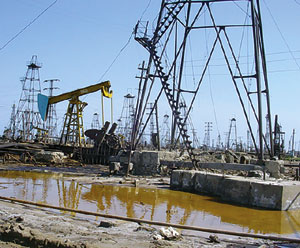What's new in production
Azerbaijan's petroleum leaks are now unburied treasure
Unburied treasure. When was the last time you stooped to pick up a penny, centavo, øre, kobo, kopeck, satang, paise, rupiah or jiao?* With their value reduced from inflation, these smallest-value coins often get thrown away or left on the sidewalk when dropped. Some small coins, like the Indonesian sen, no longer circulate because inflation nibbled away all their value. It isn’t worth the trouble to pick up the coin. The same is true of a leaky oil facility: a little bit of oil leaked or spilled isn’t worth worrying about, much less gathering for sale or use. Of course, that attitude from an earlier oil era has been superseded by environmental awareness and strict oil capture and containment policies, to the industry’s credit. But, what if the streets and fields were covered with small coins? And, what if the coin market suddenly raised the coin’s value ten-fold? Well, then it becomes worthwhile, even profitable, to gather the scattered treasure. Now, translate coins into oil droplets; it leads to a new production opportunity. This is the scene in Azerbaijan, where 19th and 20th Century drilling and production practices coated land and water with crude. Some petroleum leakage is from natural sources, but most of the leaked oil is from earlier, less-cautious oil operations. These facilities have coated the land, continuously dripping oil in small quantities. Over time, those drips have grown into many barrels. Many of these facilities continue to leak oil, creating a continuing collection opportunity. The drops, like small coins, have become a scattered treasure with the sudden oil price rise. These barrels have been waiting to be recognized, gathered and produced to the market. A fortunate confluence of opportunity and technology has led Cengroup Petroleum to sign an oil production contract with the Azeri government to begin the oil-gathering process. Using a relatively new hydrophobic oil spill product (two years on the market), the company will apply the material to collect spilled oil for processing and sale. The company estimates that some 250 million bbl of surface oil are spread across Azerbaijan’s land and water. According to the company, this is augmented each year by 1 million new bbl of leaked oil. It’s a lot like picking up qpiks* isn’t it? Of course, Azerbiajan isn’t the only place where such treasure is available. Most anyplace that the early oil pioneers operated likely has a similar problem – and a similar solution! It only requires the nose for opportunity, the will to chase it and the strength to pursue it. These are qualities the industry has in abundance. There is unburied treasure waiting to be picked up. It’s a thankless task, picking up dimes,* but someone has to do it, and it can pay well.
Nabucco pipeline. The Caspian basin produces plenty of oil, but it has large gas reserves as well. To access those reserves, a new gas pipeline is being planned. It will head north from the path of the new Baku-Ceyhan pipeline, which began delivering crude last month. Turkey has worked with Iran and Azerbiajan to bring gas from Iran’s Shah Deniz field in the Caspian Sea. The BP-operated field holds some 400 Bcm of gas and 6 Bcm/yr will flow from it to Turkey over the next 15 years. The Southern Caucasus pipeline will carry this gas and should be completed this fall. It is being built along the same route as the Baku-Ceyhan oil line, but ends in Erzurum, Turkey. Connecting there, the Nabucco pipeline will head north 2,050 mi. through Bulgaria, Romania, Hungary and end at Baumgarten an der March, Austria. There, the gas it transports will enter the European market and help diversify the region’s energy sources. The European Union is backing the project, and five EU members have put up $5.8 billion (£3.2 billion) to build the line. Construction is planned for 2008 with completion in 2011. The line will have a carrying capacity of 30 Bcm/yr and will be available to transport gas from other Caspian states. New oil developments. Cabinda Gulf Oil Co. began oil production from Lobito Field, in deepwater Block 14, offshore Angola. This is the last link in the company’s BBLT development, formed by connecting the Benguela, Belize, Lobito and Tomboco fields. Benguela and Belize produce through a compliant piled tower, while Lobito and Tomboco are a subsea project. The development is in a 1,300-ft water depth, 50 mi offshore. Roc Oil Co. began production from Cliff Head oil field in the Perth basin, offshore Western Australia. The flow began with 1,000 bopd from the C H-6 well, but five other wills will be brought onstream over the next few months to raise production above 10,000 bopd. Partners include Roc Oil Pty Limited, operator (37.5%), AWE Oil Pty Ltd (27.5%), Wandoo Petroleum Pty Ltd (24%), ARC Limited (6%) and CIECO Exploration and Production Pty Ltd (5%). Chevron Frade Ltd. (operator) with Petrobras and Frade Japao Petroleo Ltd. will develop Frade field, offshore Brazil. The field is in the Campos basin in 3,500 ft of water some 75 mi offshore. It is estimated to hold 200 million to 300 million bbl of recoverable oil and production is scheduled to begin in 2008 at 100,000 bopd. The partners recently signed construction and installation contracts for the major facilities. The project will cost about $2.4 billion. Working interest splits include Chevron Brasil Ltd. (51.74%), Petrobras (30%) and Frade Japao Petroleo Ltd. (18.26%).
|
||||||||||||||||||
- What's new in production (February 2024)
- U.S. operators reduce activity as crude prices plunge (February 2024)
- U.S. producing gas wells increase despite low prices (February 2024)
- U.S. oil and natural gas production hits record highs (February 2024)
- Dallas Fed: E&P activity essentially unchanged; optimism wanes as uncertainty jumps (January 2024)
- Enhancing preparedness: The critical role of well control system surveys (December 2023)





